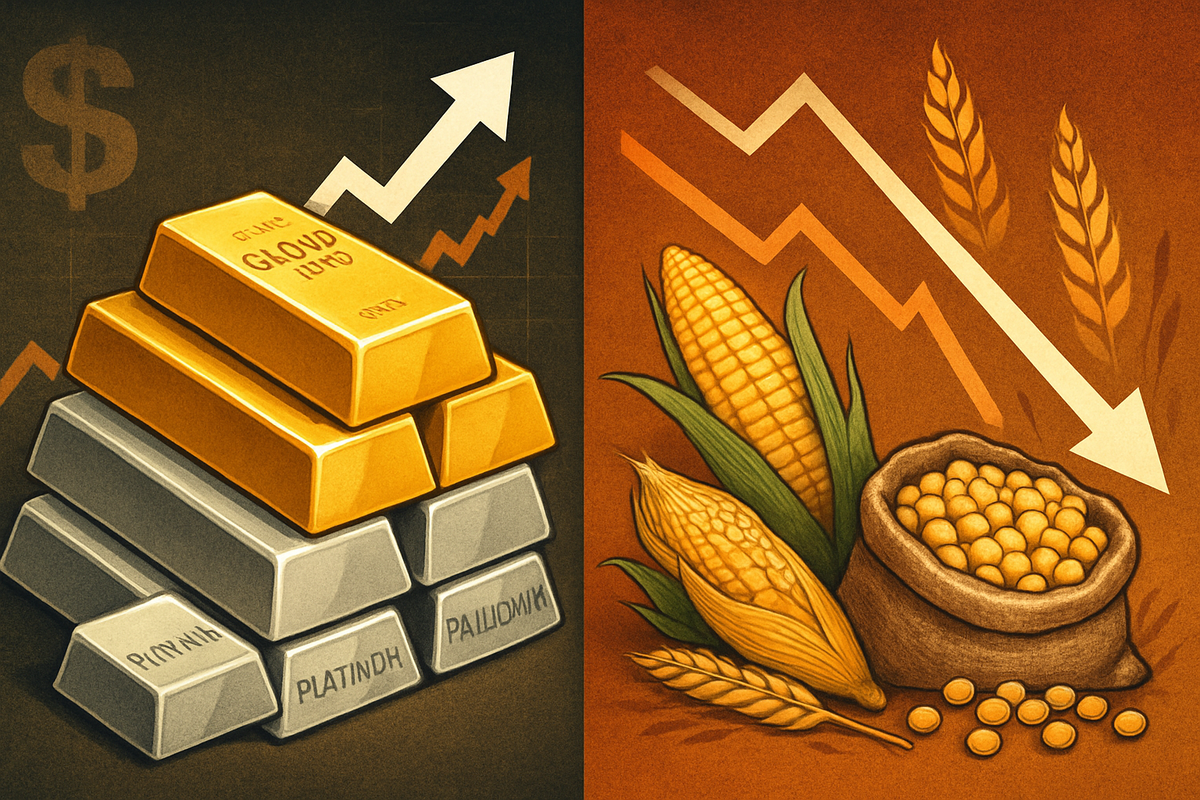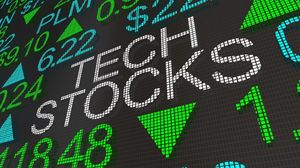September 2025: A Tale of Two Commodity Markets – Precious Metals Soar as Grains Stumble Amidst Rate Cuts and Geopolitical Tensions

September 2025 concluded with a stark divergence in the global commodity markets, painting a clear picture of winners and losers driven by a confluence of macroeconomic shifts, geopolitical uncertainties, and fundamental supply-demand dynamics. While precious metals staged an impressive rally, reaching multi-year and even all-time highs, the agricultural sector, particularly staple grains, faced significant headwinds, plummeting to multi-year lows. This "tale of two markets" has immediate implications for global inflation, corporate profitability, and investor sentiment as the world navigates evolving economic landscapes.
The month's most prominent theme was the resounding surge in precious metals. Gold (NYSE: GOLD), Silver (NYSE: SLV), Platinum (NYSE: PPLT), and Palladium (NYSE: PALL) all recorded double-digit percentage gains, with gold breaking above $3,700 per ounce and silver nearing its 2011 all-time high. This spectacular performance was largely ignited by the Federal Reserve's decision on September 17th to cut interest rates, coupled with broader expectations of a weaker U.S. dollar, which traditionally bolsters hard assets. Geopolitical tensions and macroeconomic uncertainty further fueled a flight to safety, increasing demand from exchange-traded funds (ETFs) and retail investors. Copper (NYSE: HG) also joined the rally, climbing to a 15-month high, buoyed by interest rate tailwinds, robust Chinese demand, and supply disruptions, notably at Freeport-McMoRan's (NYSE: FCX) Grasberg mine. The energy sector saw U.S. natural gas prices projected to rise due to record LNG exports, while uranium miners experienced a significant uplift following a landmark U.S.-U.K. nuclear cooperation agreement and hints of an expanded U.S. strategic uranium reserve.
Conversely, the agricultural sector endured a challenging September. Grains such as Corn (NYSE: CORN), Soybeans (NYSE: SOYB), and Wheat (NYSE: WEAT) generally plummeted to multi-year lows. This downturn was primarily a consequence of abundant global supplies, stemming from record-breaking harvests in the U.S. and South America. Weakened international demand, particularly from China, a strong U.S. dollar, and lingering geopolitical trade tensions exacerbated the declines. While some price stabilization was observed in U.S. corn and soybeans due to harvest abundance elsewhere, the overall market sentiment remained highly volatile, with extreme weather events continuing to pose persistent threats to global food systems. Lithium carbonate prices consolidated, and nickel production was forecast to outpace demand in 2025, suggesting a less favorable outlook for these industrial metals.
Corporate Fortunes Diverge: Miners Thrive, Agri-Businesses Brace for Impact
The sharp divergence in commodity prices in September 2025 has created a clear divide in the financial fortunes of public companies across various sectors. Companies involved in precious metals and copper mining are poised for substantial gains, while agricultural commodity traders, processors, and equipment manufacturers face significant headwinds.
Precious metals miners are among the primary beneficiaries of the recent rally. Companies like Agnico Eagle Mines Limited (NYSE: AEM, TSX: AEM), Kinross Gold Corporation (NYSE: KGC), and streaming companies such as Wheaton Precious Metals Corp. (NYSE: WPM, TSX: WPM), which acquire production from various mines, are expected to see a direct boost to their revenues and profitability. Higher gold and silver prices translate directly into fatter margins, increased cash flows, and potentially higher valuations. Similarly, platinum and palladium producers like Sibanye-Stillwater Limited (NYSE: SBSW, JSE: SSW) and Impala Platinum Holdings Limited (JSE: IMP, OTC: IMPUY) are benefiting from the broader bullish sentiment in precious metals, with platinum also seeing long-term support from the burgeoning hydrogen economy. Copper miners such as Southern Copper (NYSE: SCCO), Freeport-McMoRan (NYSE: FCX), and BHP Group (NYSE: BHP, ASX: BHP, LSE: BHP) are also experiencing a significant uplift, as higher copper prices enhance their top-line growth and strengthen their balance sheets, especially given copper's critical role in the global energy transition. Uranium miners like Cameco (NYSE: CCJ, TSX: CCO) and Energy Fuels (NYSE: UUUU, TSX: UUUU) are similarly benefiting from renewed interest in nuclear energy.
On the other side of the spectrum, companies heavily invested in agricultural commodities, particularly grains, are confronting a challenging environment. Agricultural commodity trading and processing giants like Archer-Daniels-Midland Company (NYSE: ADM) and Bunge Global SA (NYSE: BG) are likely to experience squeezed margins, inventory value write-downs, and potential disruptions in their supply chains due to declining corn, soybean, and wheat prices. Farmers, facing reduced incomes from lower crop prices, are expected to cut back on capital expenditures. This directly impacts agricultural equipment manufacturers such as Deere & Company (NYSE: DE) and AGCO Corporation (NYSE: AGCO), which could see a downturn in sales and profitability. Furthermore, agricultural input providers like Corteva Agriscience (NYSE: CTVA), Nutrien Ltd. (NYSE: NTR, TSX: NTR), and The Mosaic Company (NYSE: MOS), which supply seeds, fertilizers, and crop protection chemicals, may also face reduced demand as farmers optimize or cut back on expensive inputs to preserve their dwindling profit margins.
Wider Significance: Economic Barometers and Shifting Global Dynamics
The divergent commodity trends observed in September 2025 carry significant wider implications, serving as crucial economic barometers and reflecting profound shifts in global dynamics. The rally in precious metals, driven by interest rate cuts and economic uncertainty, signals persistent concerns about global growth and a potential weakening of fiat currencies. This trend aligns with broader industry observations of investors seeking safe-haven assets amidst a complex macroeconomic backdrop, potentially indicating a defensive posture in capital markets.
The strength in copper underscores its enduring role as a bellwether for industrial demand and global economic health, particularly with robust consumption from China, suggesting resilience in certain manufacturing sectors despite overall economic anxieties. Moreover, the renewed focus on uranium and nuclear energy, spurred by international agreements and strategic reserve discussions, highlights an accelerating global pivot towards cleaner energy sources and a decreased reliance on traditional fossil fuels, further emphasizing the energy transition narrative. This could have ripple effects on the broader energy market, influencing investment in renewables and other power generation technologies.
Conversely, the substantial decline in grain prices, fueled by oversupply and weakened demand, points to a complex situation for global food security and inflationary pressures. While lower food commodity prices might offer some relief to consumers struggling with food inflation, they pose severe challenges for farmers and agricultural economies, potentially leading to financial distress in rural areas. This situation could also influence trade policies, with countries potentially reviewing agricultural subsidies or import/export regulations to protect domestic producers or manage food supplies. Historically, periods of agricultural oversupply have often led to sustained price weakness, impacting agricultural sector investments for extended periods. The U.S. Department of the Interior's inclusion of silver in its draft list of critical minerals also has long-term regulatory implications, potentially streamlining permitting for silver mining projects and attracting more investment into the sector.
What Comes Next: Volatility, Adaptation, and New Opportunities
Looking ahead, the commodity markets are poised for continued volatility, driven by the same macroeconomic and geopolitical forces that shaped September's performance. In the short term, the trajectory of interest rates and the U.S. dollar will remain critical determinants for precious metals. Any further dovish signals from central banks or escalating global tensions could sustain the rally in gold and silver, potentially pushing them to new record highs. Copper's performance will largely depend on the resilience of industrial demand, especially from China, and the absence of further significant supply disruptions. The nuclear energy sector, including uranium, is likely to maintain its upward momentum as the global energy transition accelerates and countries prioritize energy security.
For the agricultural sector, the outlook remains challenging. Abundant global supplies are expected to keep a lid on grain prices in the near term, although extreme weather events or unexpected shifts in demand could introduce sudden price spikes. Agricultural companies may need to implement strategic pivots, focusing on cost control, supply chain optimization, and diversification into higher-value agricultural products or processing. Market opportunities may emerge for investors willing to take a long-term view on agricultural assets, especially those with strong balance sheets and efficient operations, anticipating a eventual rebalancing of supply and demand. Conversely, the continued oversupply in certain agricultural commodities could present challenges for companies reliant on high prices, necessitating adaptations in business models and potentially leading to industry consolidation. Investors should monitor geopolitical stability, central bank policies, and global weather patterns as key indicators for future commodity price movements.
Comprehensive Wrap-up: A Market in Flux
September 2025 delivered a clear message: the commodity market is in a state of flux, highly sensitive to monetary policy, geopolitical events, and fundamental supply-demand shifts. The outstanding performance of precious metals and copper underscored a flight to safety and persistent industrial demand, respectively, signaling underlying economic anxieties coupled with targeted growth drivers. Meanwhile, the significant decline in grain prices highlighted the challenges of oversupply and weakened global demand, placing considerable pressure on the agricultural sector.
Moving forward, investors must assess the market with a nuanced perspective. The strength in precious metals and critical industrial metals like copper and uranium points to potential opportunities in mining and related sectors, particularly for companies with robust operations and exposure to these commodities. However, the agricultural sector faces a period of consolidation and adaptation, with profitability likely to remain constrained for many players. The long-term impact of these trends includes potential shifts in global wealth distribution, evolving energy policies, and continued scrutiny on food security and agricultural sustainability.
Key takeaways from September's performance include the powerful influence of central bank decisions on hard assets, the enduring role of geopolitical stability in shaping investor behavior, and the increasing impact of climate change on agricultural output. Investors should closely watch upcoming interest rate decisions, the trajectory of the U.S. dollar, and any developments in major commodity-consuming economies like China. Furthermore, monitoring climate patterns and their potential impact on future harvests will be crucial for navigating the agricultural commodity landscape in the coming months.
This content is intended for informational purposes only and is not financial advice
More News
View More




Recent Quotes
View More
Quotes delayed at least 20 minutes.
By accessing this page, you agree to the Privacy Policy and Terms Of Service.